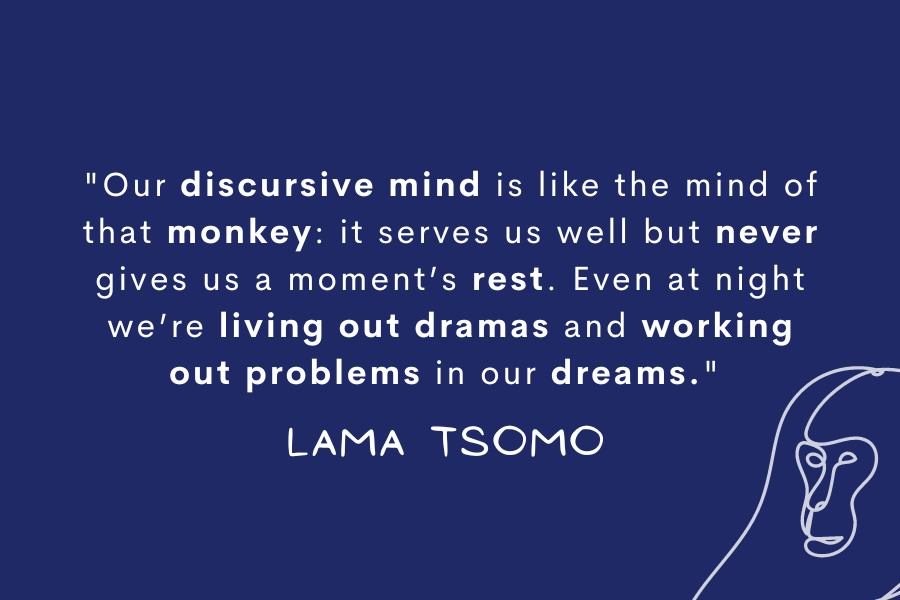You may have heard meditation and Buddhist teachers refer to the “monkey mind.” In this short excerpt from Lama Tsomo’s book, Wisdom & Compassion (Starting with Yourself) she shares the origin story of this concept, while helping us understand the nature of the mind.
Once, long ago, a man received a wonderful present from a master: a magical monkey that could do anything the man asked of it. Well, of course he was thrilled! He took the monkey along with him and asked it to do all sorts of useful things. In no time at all, it would finish each task and come running back for the next order. The man had the monkey build him a palatial house. In no time at all, the monkey had finished it. Now our friend was really thrilled. What’s not to like?
The man went to bed for the night and found out. The monkey kept pestering him, “NOW what do you want me to do? What next?” The man could never rest, ever! Day and night the monkey hounded him with requests for more work, which it finished in no time. Then it was back for more.
At his wits’ end, the man went back to the master. “Help! You’ve got to give me a way to deal with this monkey so that it doesn’t keep on bothering me day and night! What can you do?!”
The master gave him one curly hair. He intoned, “Have the monkey make the hair go straight.” The master demonstrated pulling the hair straight. As soon as he let go, the hair bounced back to its former shape. That was it. The man took the hair and gave it to the monkey, ordering it to make the hair straight. The monkey sat down, fully focused on the little hair. He pulled it straight. It bounced back. He pulled it again. It bounced back again. So it went for about a minute. The man raced to his bed and gratefully passed out. This story was from the days before straightening irons.
Many Buddhists refer to the “monkey mind,” and now you know why. Our discursive mind is like the mind of that monkey: it serves us well but never gives us a moment’s rest. Even at night we’re living out dramas and working out problems in our dreams. Great masters who rest in the clear light of basic awareness need very little sleep—and I daresay they get more rest!
Our meditative support acts like the curly hair. After lifetimes of busily dashing after thoughts, if we ask the mind to suddenly “take five,” how could it possibly do that? If we ask a puppy to do a “down-stay” for an hour in the first lesson, we’re going to have a very unhappy puppy and owner. It simply ain’t gonna happen. We’d do well to give it a bone to chew on. It still won’t stay for an hour, but it’ll stay for a bit.

I don’t know of any Theravada or Mahayana Lineages that use an image as a meditative support in the way that we do, but I like the fact that Vajrayana does, in the beginning. As I’ve tried one after another Vajrayana practice, I’ve found these practices very realistic in meeting our minds as they are NOW. From that starting point, the practices lead us to loftier, more rarified states. The higher the level of practice, the stronger the medicine, until you’re experiencing some really amazing things. Most important, your mind has really changed. If we try to start at the lofty places, though, the mind will be like that fidgety untrained puppy being asked to do a “down-stay” for an hour.
Do I need to stop my thoughts in order to meditate?
Remember that you’re not expected to sit there and think of nothing for the whole time. Again, that’s not realistic. But many Westerners beginning meditation do make this mistake, drive themselves crazy in the attempt, and get discouraged and/or give up. If, as we meditate, thoughts arise and fall away, like waves in the ocean, no problem. That’s reality. Empty awareness gives rise to appearances, and thoughts are a kind of appearance. If we could let well enough alone . . . we wouldn’t be in this mess of a movie we call Samsara. The Buddha also saw the appearances, but he didn’t have to do or think anything about them, so he could let them be.
But rarely can we let well enough alone. Because we identify with one apparition, “me,” ego, we have a vested interest in following the course of this movie, in which we are both audience and the main character.
Excerpt, pages 40-41, from Ancient Wisdom for Our Times. Tibetan Buddhist Practice: Wisdom & Compassion (Starting with Yourself) (c)2021 Lama Tsomo LLC. Published by Namchak Publishing Company LLC, USA.
